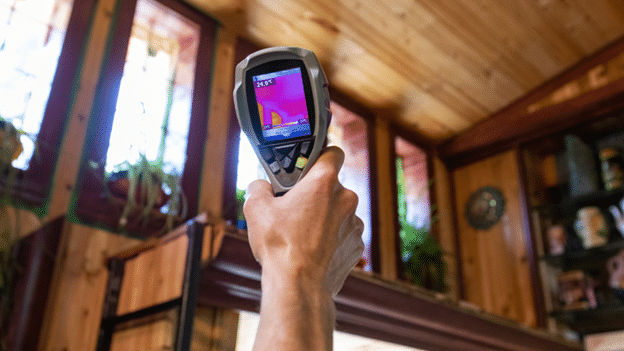There are various types of indoor air quality tests available to help assess the levels of pollutants in your home. These tests will ensure that the air you breathe is safe and clean. Indoor air quality (IAQ) plays a critical role in maintaining a healthy and comfortable home environment. The air inside your home can harbor pollutants such as allergens, dust, volatile organic compounds (VOCs), mold spores, and other contaminants. These pollutants can affect your health and overall well-being. Indoor air quality tests help identify these pollutants and provide insight into the quality of the air you’re breathing.
In this blog post, we’ll explore the different types of indoor air quality tests, how they work, and the testing devices. We will also discuss whether you should consider DIY testing or opt for professional assistance.
Types of Indoor Air Quality Tests (IAQ Tests)
There are several different types of IAQ tests, each designed to detect specific pollutants:
- Allergen Testing: These tests focus on identifying common allergens such as pollen, pet dander, and dust mites that can trigger allergic reactions. Allergen tests are usually performed using air sampling devices or surface swabs to gather data.
- Mold Testing: Mold spores can circulate through your home’s air and lead to health problems like respiratory issues and allergies. Mold tests typically involve taking air samples or surface samples to determine the presence of mold and the specific types of mold spores in the environment.
- VOC Testing: Volatile Organic Compounds (VOCs) are harmful chemicals that can be released from household products such as paints, cleaners, and building materials. VOC testing involves sampling the air to detect chemicals like formaldehyde and benzene that could be present in high concentrations.
- Radon Testing: Radon is a colorless, odorless gas that can enter your home through cracks in the foundation and is linked to lung cancer. Radon tests use specialized kits to measure radon levels in the air.
- Carbon Monoxide Testing: Carbon monoxide (CO) is a deadly, odorless gas produced by combustion appliances like gas stoves and furnaces. IAQ tests can detect CO levels to ensure your home is free of this harmful pollutant.
- Particulate Matter Testing: Particulate matter (PM) refers to tiny particles, such as dust, smoke, and soot, that can be inhaled and harm respiratory health. PM testing involves monitoring the concentration of these particles in the air.
How Indoor Air Quality Testing Works
IAQ testing usually involves taking samples of the air or surfaces in your home to detect pollutants. The steps may include:
- Air Sampling: Air samples are collected using specialized devices that pull air through filters to capture particles, allergens, mold spores, and chemicals. These samples are then analyzed in a lab to identify the types and concentrations of contaminants.
- Surface Testing: Swabs are used to collect samples from surfaces where pollutants like dust, mold, or allergens have settled. This method helps determine the presence of pollutants in areas not detected by air sampling alone.
- Continuous Monitoring: Some air quality tests involve continuous monitoring devices that track indoor pollutants over time. This provides real-time data on air quality trends.
Testing Devices for Indoor Air Quality
There are various testing devices and equipment used for IAQ testing:
- Air Quality Monitors: These portable devices can measure a range of pollutants, such as VOCs, particulate matter, and humidity levels. They offer real-time feedback and often come with digital displays.
- Radon Test Kits: Simple test kits can measure radon levels over a period of time, typically a few days to a few months. They are easy to use and available for homeowners.
- Carbon Monoxide Detectors: These are crucial devices for any home and can continuously monitor for dangerous CO levels, alerting you to potential risks.
- Professional Lab Equipment: Professionals use advanced testing kits to capture air or surface samples. Then they send these samples to a lab for in-depth analysis. These tools can detect more complex pollutants with greater accuracy.
Can You Do Indoor Air Quality Testing Yourself?
DIY air quality tests can be a good starting point, especially for basic pollutants like VOCs or particulate matter. Many over-the-counter test kits are available for home use, such as:
- Radon Test Kits: Widely available and simple to use.
- Carbon Monoxide Detectors: Easily installed in key areas of your home.
- Portable Air Quality Monitors: These provide general information about indoor pollutants and are useful for detecting trends.
However, DIY testing has its limitations:
- Accuracy: Home test kits may not be as accurate or comprehensive as professional testing.
- Limited Scope: Most DIY kits only detect specific pollutants and may miss other serious concerns, such as mold or hidden VOCs.
- Analysis: Professional testing includes lab analysis that can identify pollutants at a more detailed level.
The Importance of Professional IAQ Testing and Air Monitoring
While DIY testing can give you a general idea of your indoor air quality, professional IAQ testing is recommended for a more thorough assessment. Here’s why professional testing is crucial:
- Comprehensive Analysis: Professionals use advanced equipment that can detect a wider range of pollutants, including mold spores, VOCs, radon, and more.
- Expert Interpretation: Professionals can interpret test results more accurately, identifying potential sources of pollutants and offering recommendations for mitigation.
- Health and Safety: Professional testing is essential if you or your family are experiencing respiratory issues, allergies, or other health problems related to poor air quality.
- Long-Term Monitoring: Regular IAQ testing helps you stay proactive about your home’s air quality. Continuous monitoring can alert you to sudden changes, like a spike in radon or carbon monoxide levels, allowing for prompt action.
Investing in Indoor Air Quality Testing
Ensuring good indoor air quality is vital for your health and comfort. While DIY testing can provide some insights, professional IAQ testing offers a more accurate and comprehensive analysis. Whether you’re concerned about allergens, mold, or dangerous gases like radon, investing in air quality testing can help you create a cleaner, safer living environment. Regular testing and continuous monitoring can also give you peace of mind.
Air Rescue Air Conditioning is your trusted expert when it comes to improving indoor air quality. We offer a variety of solutions to help you breathe easier. These include UV lights, advanced air filtering systems, duct cleaning services, and smart thermostats for better air control. Contact us today to learn more about how we can help enhance the air quality in your home and ensure a healthier living space for you and your family.
Whether you require installation, repair, or maintenance, our technicians will assist you with top-quality service at any time of the day or night. Take comfort in knowing your indoor air quality is the best it can be with MOE heating & cooling services Ontario's solution for heating, air conditioning, and ventilation that’s cooler than the rest.
Contact us to schedule a visit. Our qualified team of technicians, are always ready to help you and guide you for heating and cooling issues. Weather you want to replace an old furnace or install a brand new air conditioner, we are here to help you. Our main office is at Kitchener but we can service most of Ontario's cities
Source link



